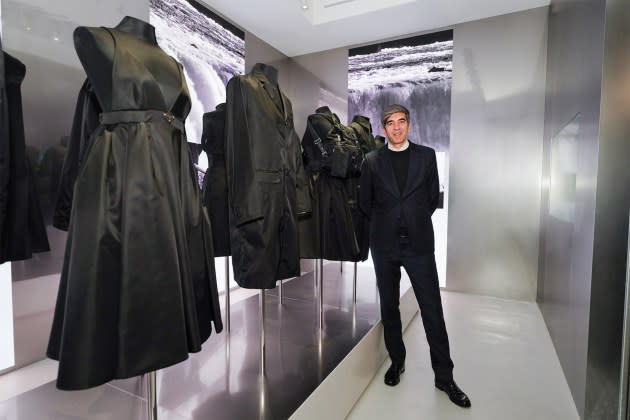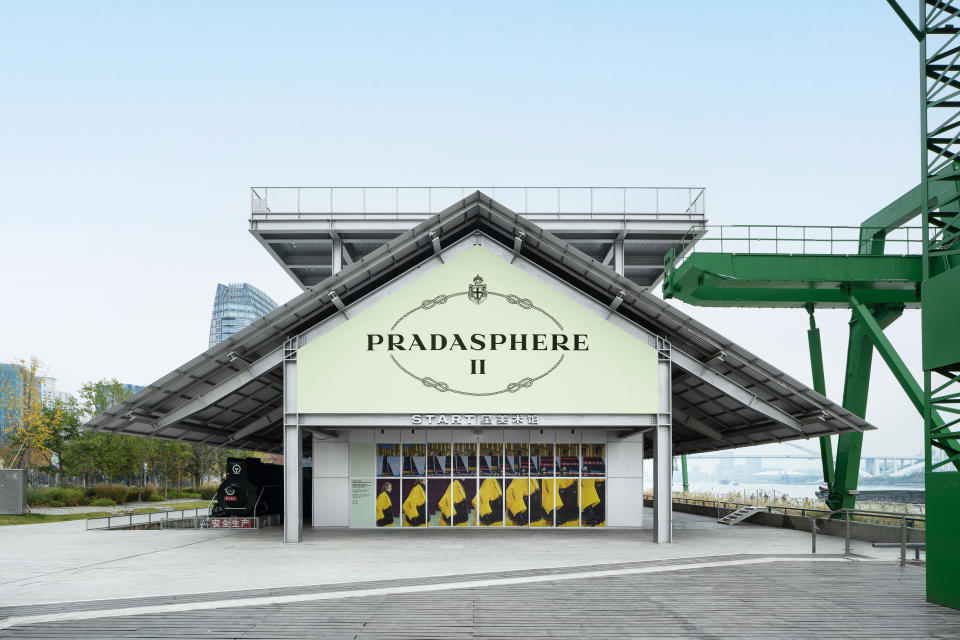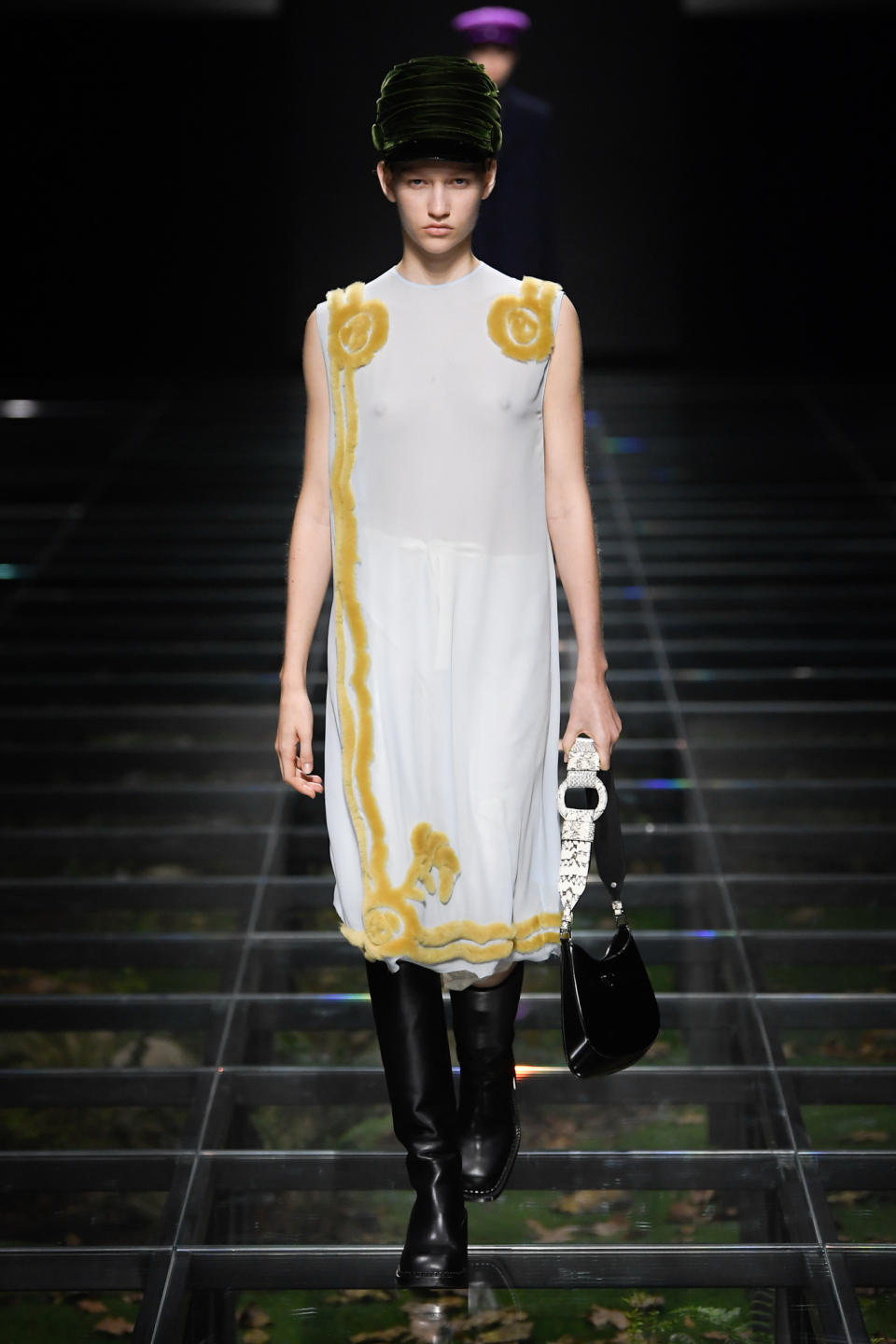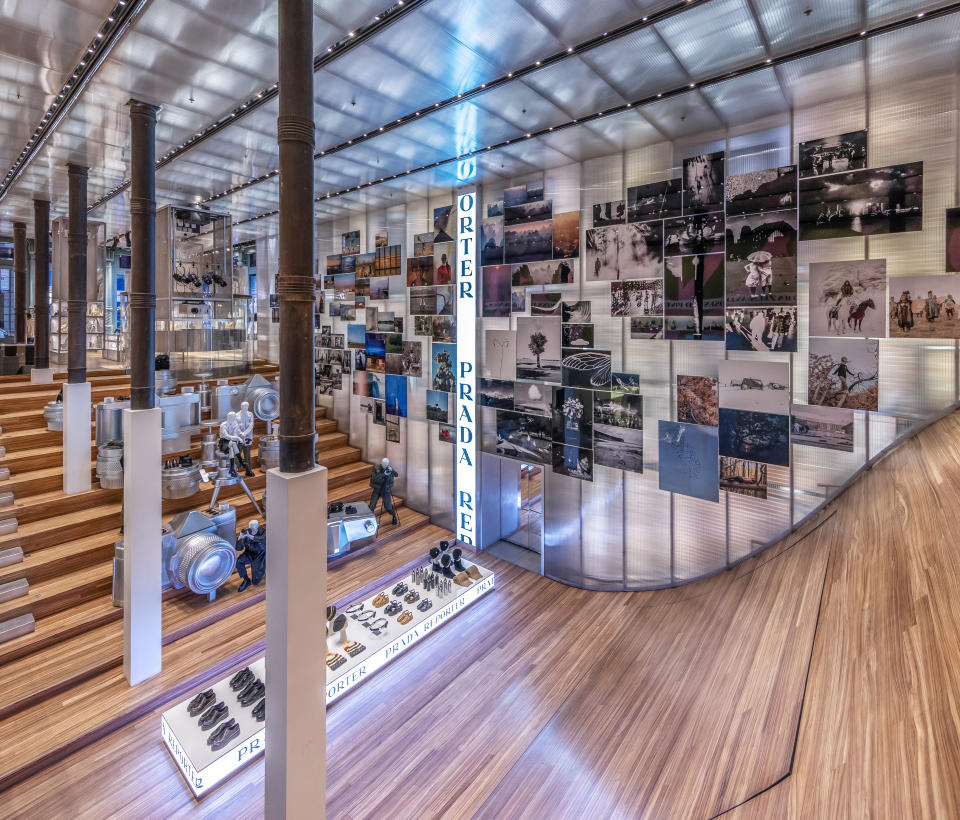EXCLUSIVE: CEO Talks: Gianfranco D’Attis on the ‘Pradaness’ Potential, Retail Growth
- Oops!Something went wrong.Please try again later.
- Oops!Something went wrong.Please try again later.

MILAN — Gianfranco D’Attis admits he is “obsessed with details” and acknowledges that he is leveraging this character trait and channeling his retail experience in his role as Prada’s chief executive officer.
For years the Italian luxury brand has invested in a long-term retail strategy, which is clearly paying off. Retail sales of the Prada brand in 2023 increased 12 percent to 3.48 billion euros, including 10 percent growth in the fourth quarter, accelerating on the third quarter across all categories. The increase was driven by full-price like-for-like sales and solid growth across categories, genders and age groups. While sister brand Miu Miu has been gaining traction and growing exponentially, Prada continues to account for the bulk of revenues at the group, which last year reported sales of 4.72 billion euros, up 13 percent on 2022.
More from WWD
Joey King Plays With 3D Effects in Textual Prada Cloquet Look for 'We Were the Lucky Ones' Premiere
All About Design, Nothing About Design: Prada Frames 2024 Edition to Discuss Home as Culture
D’Attis joined Prada in January 2022 as the group was going through a managerial reorganization and is the first executive outside of the family to hold the CEO role. Chairman Patrizio Bertelli and Miuccia Prada were previously co-CEOs of the group and of the signature brand. D’Attis reports to group CEO Andrea Guerra, who was appointed to that job at the same time as D’Attis joined.
D’Attis was previously president of Christian Dior Couture Americas. Earlier, he was international managing director of Jaeger-LeCoultre.
In an exclusive interview, his first since his appointment, D’Attis provided his views on Prada’s growth potential, with a focus on the U.S. and China; leveraging the brand’s “strong story to tell,” and further improving the client-centric experience, for example with the recent unveiling of a private apartment at the Paris store on Rue du Faubourg Saint-Honoré.
WWD: Prada has been reporting an acceleration in sales and profitability over the past few seasons. What do you attribute this performance to?
Gianfranco D’Attis: I think this was a response to the appreciation for the brand, because it affirms the relevance of desirability of our products in the industry. I think it has been clear that over the past we have been consistently investing in the brand without compromising. And I think we are starting to see the first results. Plus obviously, we can say that today the brand has a very well-balanced product mix driving growth and resilience. And obviously, the company’s focus is always on uncompromised quality and on long-term, sustainable growth. And we have started to benefit also from an evolved organization and more valuable talent, and a solid precision in execution of the company’s strategy.
WWD: Prada’s retail growth of 12 percent was driven by like-for-like sales. Can you elaborate on this performance?
G.D.: We continue to have a bit more of an organized retail excellence, with an obsession and attention to like-for-like in-store productivity. We have a strong focus on retail; KPIs are critical for us, driven by conversion. We have improved a lot in our execution of our 360-degree strategy. This means having the right product, the right experience in store with the right communication approach, to really all be aligned, and create a strong impact for our customer.
We have invested and we are continuing to invest in client experience in stores, which is critical to really create trust, a trusted relationship between store staff and customer. This is our consistent retail culture. We have a very significant part of the business that is generated by existing loyal customers, but also we are working to attract new and young ones, and convert them into brand ambassadors.
WWD: What can you tell us about the year ahead, given the macroeconomic, social and geopolitical issues?
G.D.: 2024 has started well. It’s a year where we have to say we are going back to a certain industry growth normalization, the market enters a new phase. After three years of exceptional growth, we are expecting a greater polarization this year. We need to be obsessed with delivering market share gains this year. We need to continue to do better than the market.
WWD: What are the main challenges for Prada in your opinion?
G.D.: We are in a transformation mode. I’m here because I’m a strong retailer, bringing a lot of retail know-how and client-centric strategies, which will bring us to the next level in terms of retail maturity. We were always good retailers with the best-in-class product but we want to grow in terms of client experience, offering a superior client experience in-store, making sure that we can evolve on this level because we have such a strong story to tell. We have such an incredible, creative and innovative spirit driven by our creative directors Miuccia Prada and Raf Simons that have a strong partnership and dialogue, which is so unique.
We have an opportunity to grow into key markets over the next three to five years, in Asia and in the U.S. China’s one of our key bets over the next three to five years, where we are still under-penetrated. And we have to catch up, I think we have an opportunity to grow. And we have a plan to enhance our distribution with larger, more beautiful stores to offer an upgraded client experience in China.

WWD: Prada has been exploring new categories, such as jewelry with recycled gold and home. What is the product extension strategy for the brand?
G.D.: We are trying to integrate new categories, home and jewelry in our flagships and in our epicenters to also try to attract the new and younger consumers. We selectively integrate those categories in markets where we have the potential opportunity to speak to a new consumer. It’s very selective; we don’t want to have home and jewelry everywhere.
I think we have a very well-balanced brand mix with a strong core of leather goods but also ready-to-wear and footwear have been an extreme accelerator in the past two years and what is very important to mention is that we attract new clientele through these categories.
[Speaking of the brand DNA] I think this is what the customer at the end of the day appreciates, this clarity, this consistent creativity and vision. And innovation is what is very much making the difference in this world.

WWD: Several luxury competitors have increased their prices. What is Prada’s take on this strategy?
G.D.: We have increased our prices over the past year but in line with the market and we haven’t had extraordinary price increases.
We will continue to enrich our price-point pyramid, also on the luxury segment with the introduction of jewelry with recycled gold and we have been working on getting some luxury customers with a specific tailor-made offer on the high end, through specific services and spaces within our distribution. We just opened our private apartment in Paris on the third floor above our store on Rue du Faubourg Saint-Honoré. We have a beautiful space to offer a very intimate, very specific customer experience and we’re offering to our very selective customer a very unique client experience where you have art, hospitality, and the real true “Pradaness” experience for men and women. We want to really offer something unique that you can’t get elsewhere. We would like to integrate it in the epicenters worldwide, in Milan, New York, Los Angeles and Tokyo.
WWD: How is business split between menswear and womenswear?
G.D.: Both men’s and women’s category are very well-balanced. It’s true that over the past 12 months we saw an acceleration on men’s, which is very good to see.
WWD: While retail sales last year grew 17 percent to 1.44 billion euros in Asia Pacific and 10 percent in Europe to 1.31 billion euros, jumping 31 percent to 484 million euros in Japan, revenues in the Americas decreased 2 percent to 767 million euros, and were flat at constant exchange rates. However, in the U.S. sales did show a sequential improvement in the fourth quarter, supported by some repatriation of spending. Why was the performance less buoyant in this market compared to others? Is the acquisition of the building in New York housing the Prada store on Fifth Avenue signaling a change?
G.D.: We had just a different strategy in the past; Asia was the priority and we developed Asia more. So now we are changing it and one of the reasons for this investment in New York is clearly the importance of the market. We wanted to secure the location and we are going to upgrade it and enlarge it, improve the client experience, and hopefully have a surprise in terms of new hospitality concepts to make sure that we engage with the American consumer on a different level. We have plans to develop Miami in 2024, we have plans to penetrate Texas with openings in Houston and Dallas in 2024, and Austin, Chicago and Philadelphia where we are not present.
There’s still a lot of potential, in the Middle East and Latin America. It’s important to prioritize, but clearly there is potential everywhere.
As we said before, we have a long-term strategy in the next three to five years. Our focus is the U.S. and Asia, specifically China, where we want to really try to make a difference, try to get to know the customer better, to invest in a narrative, in storytelling so that the customer gets to know the Pradaness. We will invest in the future also more and more in events that represent the Pradaness, such as Pradasphere or Prada Mode and all these platforms that are really there to convey a cultural message to our clients through the lens of Prada.

WWD: You certainly bring your international experience — developed also in the U.S. — to the brand, as you relocated to New York from Geneva when you were named managing director of Christian Dior Couture North America in April 2019.
G.D.: I spent a lot of time in the U.S. and I think we have a significant opportunity in the American market. That’s why I’m also here. I’m here because I think the brand has an opportunity to further gain market share and the retail presence is still very limited in the U.S. So we are going to invest in America, in new, bigger and more productive stores. We were pioneers starting from 2000s with the Epicenter in New York and Los Angeles with Rem Koolhaas and in Tokyo with Herzog & de Meuron that offers a unique client experience. But not only — we have artistic talks there, we have a beautiful platform for intellectual gatherings, for film screenings or performances. So the epicenter as a concept, it’s not just a commercial platform, but also a very cultural platform that our customers love to engage in.
The acquisition of the building on Fifth Avenue is a strong signal and message that we want to continue to invest and secure key retail locations in key cities like New York, Milan, London, Paris, Shanghai, Hong Kong and Tokyo. We want to make sure that we will secure brand visibility in those key markets to offer an evolved client experience. There are plans for Milan, too — after all, the city is our home — to increase our footage. And to increase our client experience here. I won’t be able to share too much insight, it’s going to be something big.
WWD: Commenting on year-end results in March, chairman Patrizio Bertelli underscored that “innovation, dynamism and flexibility will be even more key to our success in 2024, and I am confident that our reinforced organization will be able to further evolve the group.” Can you elaborate on these remarks?
G.D.: We are about flexible organization, adapting to external challenges and internal transformational process. We are a very dynamic group with dynamic brands that focus on retail. We are about creativity and innovation which is critical, which obviously sparks the dialogue in fashion between Miuccia Prada and Raf Simons, which is very, very important to us and to the brand. And we are about pushing the boundaries always, surprising with creativity and innovation. Also through unexpected partnerships, such as with Axiom [Space, the architect of the world’s first commercial space station, on NASA’s lunar space suits for the Artemis III mission] or Adidas and this will help us to continuously enlarge our audience, which for us is important.
WWD: There has been talk about a double listing, which group CEO Andrea Guerra has quashed. Is there any comment you can make?
G.D.: We are very happy with being listed, but this is a question that we have to ask the ownership and Andrea Guerra. I think we have to do what we do best, create brand desirability and best-in-class client experience in our stores. The dream, you know, I think this is the substance, this product that our clients love. I think this is what we are good at delivering, this cultural substance through the lens of Prada is what we’re all about, and what makes us different in the market.
WWD: What do you look for when recruiting your team? How would you describe your management style?
G.D.: I have an obsession for details, creativity, innovation, being curious, this obsession of conquering the world, this obsession of conquering new customers and in trying to do the best and that’s what we’re looking for today.
Best of WWD

